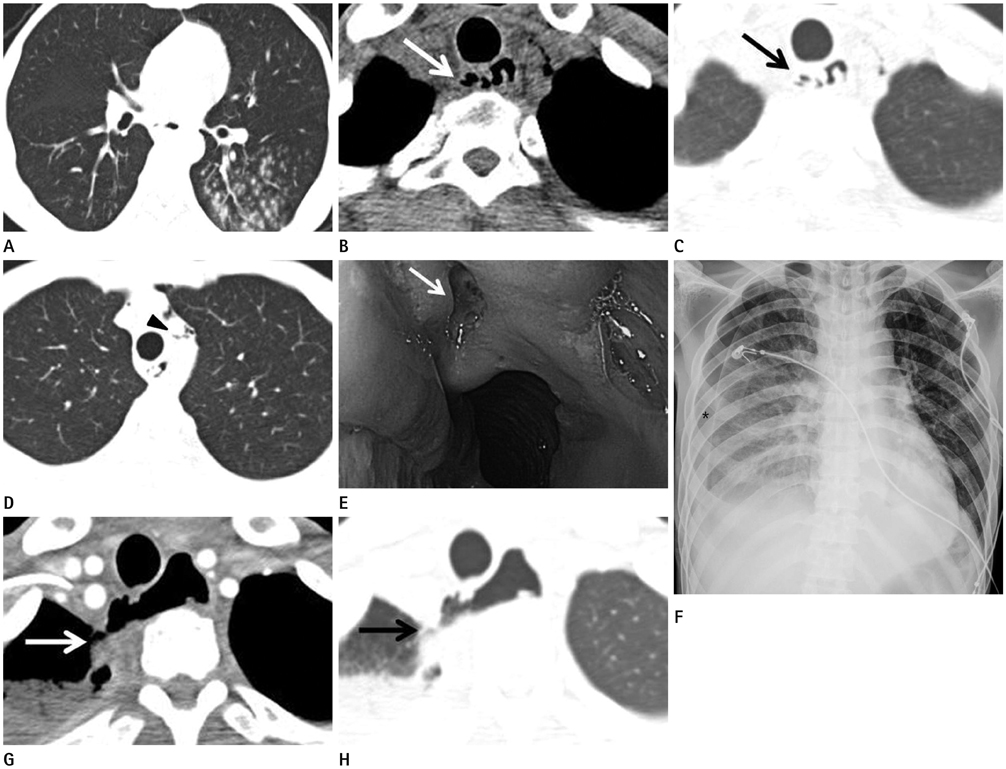J Korean Soc Radiol.
2014 Mar;70(3):209-212. 10.3348/jksr.2014.70.3.209.
Esophago-Pleural Fistula with Multiple Esophageal Ulcers in Human Immunodeficiency Virus Infected Patient: A Case Report
- Affiliations
-
- 1Department of Radiology, Seoul Medical Center, Seoul, Korea. ykradio@medimail.co.kr
- 2Department of Internal Medicine, Seoul Medical Center, Seoul, Korea.
- 3Department of Thoracic and Cardiovascular Surgery, Seoul Medical Center, Seoul, Korea.
- KMID: 1839434
- DOI: http://doi.org/10.3348/jksr.2014.70.3.209
Abstract
- Esophagitis is a common complication in patients with human immunodeficiency virus (HIV) infection. Esophagitis in HIV infected patient is caused by candidiasis, cytomegalovirus, herpes simplex virus, or idiopathic esophagitis with no detectable etiology. Esophagitis in HIV infected patient is occasionally combined with esophageal ulcers. We report chest CT findings and clinical manifestation of esophago-pleural fistula with pneumothorax in a HIV infected patient, who was treated for aspiration pneumonia and esophageal ulcers.
MeSH Terms
Figure
Reference
-
1. Mönkemüller KE, Wilcox CM. Diagnosis and treatment of esophagitis in AIDS. Compr Ther. 2000; 26:163–168.2. Ehrenpreis ED, Bober DI. Idiopathic ulcerations of the oesophagus in HIV-infected patients: a review. Int J STD AIDS. 1996; 7:77–81.3. Wilcox CM, Schwartz DA, Clark WS. Esophageal ulceration in human immunodeficiency virus infection. Causes, response to therapy, and long-term outcome. Ann Intern Med. 1995; 123:143–149.4. Giménez A, Franquet T, Erasmus JJ, Martínez S, Estrada P. Thoracic complications of esophageal disorders. Radiographics. 2002; 22 Spec No:S247–S258.5. Kumar S, Singh A, Matreja PS, Kler SK. A case report of a spontaneous oesophageal pleural fistula. J Clin Diagn Res. 2013; 7:522–524.6. Jang KM, Lee KS, Lee SJ, Kim EA, Kim TS, Han D, et al. The spectrum of benign esophageal lesions: imaging findings. Korean J Radiol. 2002; 3:199–210.7. Han SY, McElvein RB, Aldrete JS, Tishler JM. Perforation of the esophagus: correlation of site and cause with plain film findings. AJR Am J Roentgenol. 1985; 145:537–540.8. Abbott OA, Mansour KA, Logan WD Jr, Hatcher CR Jr, Symbas PN. Atraumatic so-called "spontaneous" rupture of the esophagus. A review of 47 personal cases with comments on a new method of surgical therapy. J Thorac Cardiovasc Surg. 1970; 59:67–83.9. Wechsler RJ. CT of esophageal-pleural fistulae. AJR Am J Roentgenol. 1986; 147:907–909.
- Full Text Links
- Actions
-
Cited
- CITED
-
- Close
- Share
- Similar articles
-
- A Case of Nontuberculous Mycobacterium Infection Complicated by an Esophagomediastinal Fistula in a Human Immunodeficiency Virus Patient
- The Management of Delayed Post-Pneumonectomy Broncho-Pleural Fistula and Esophago-Pleural Fistula
- Double Bypass of Esophagus and Descending Thoracic Aorta for the Treatment of Esophagopleural and Aortopleural Fistula
- A Case of Ankylosing Spondylitis in a Patient with Human Immunodeficiency Virus
- A Case of Acute Erythroleukemia in a Human Immunodeficiency Virus-Infected Patient


